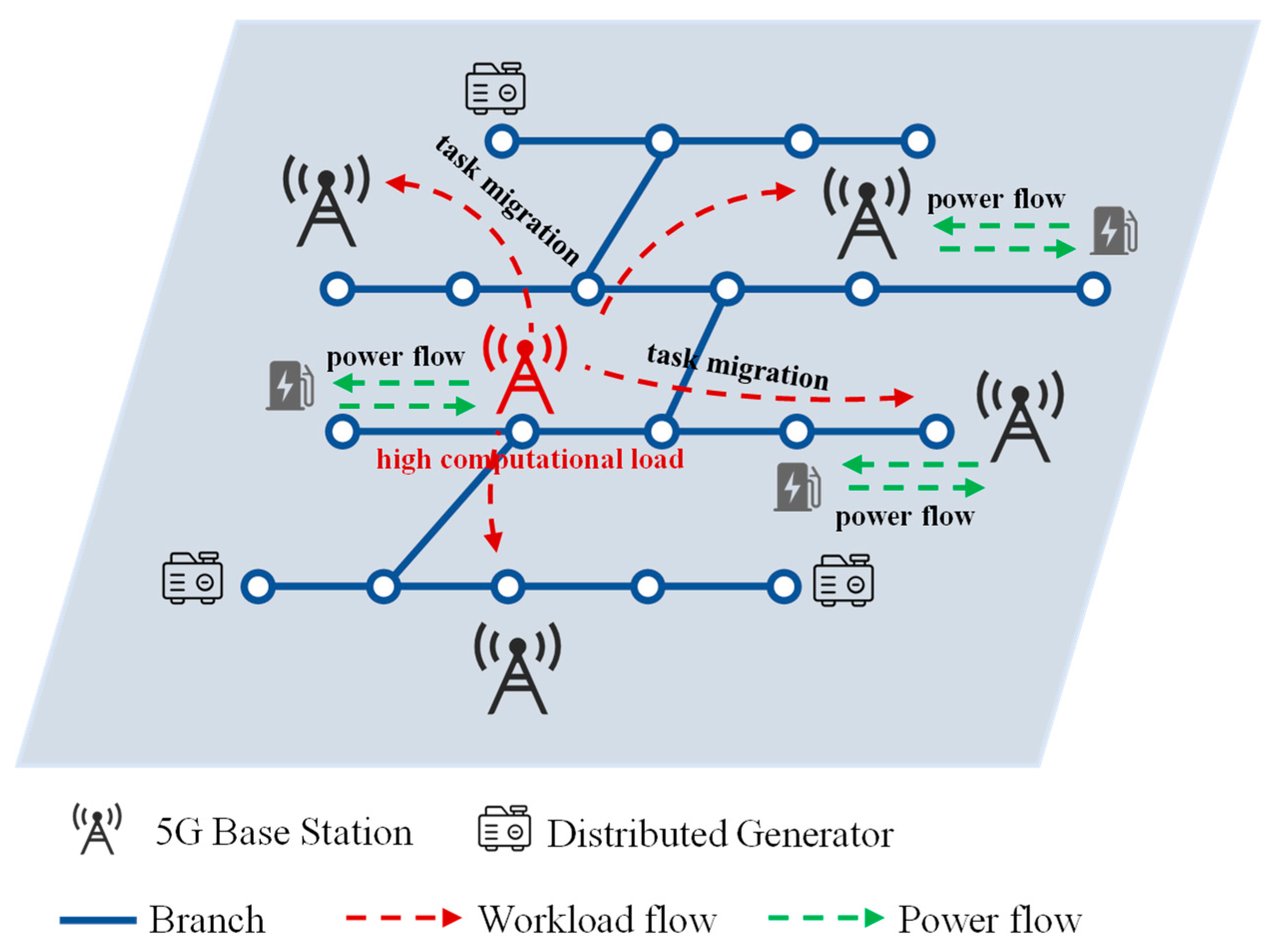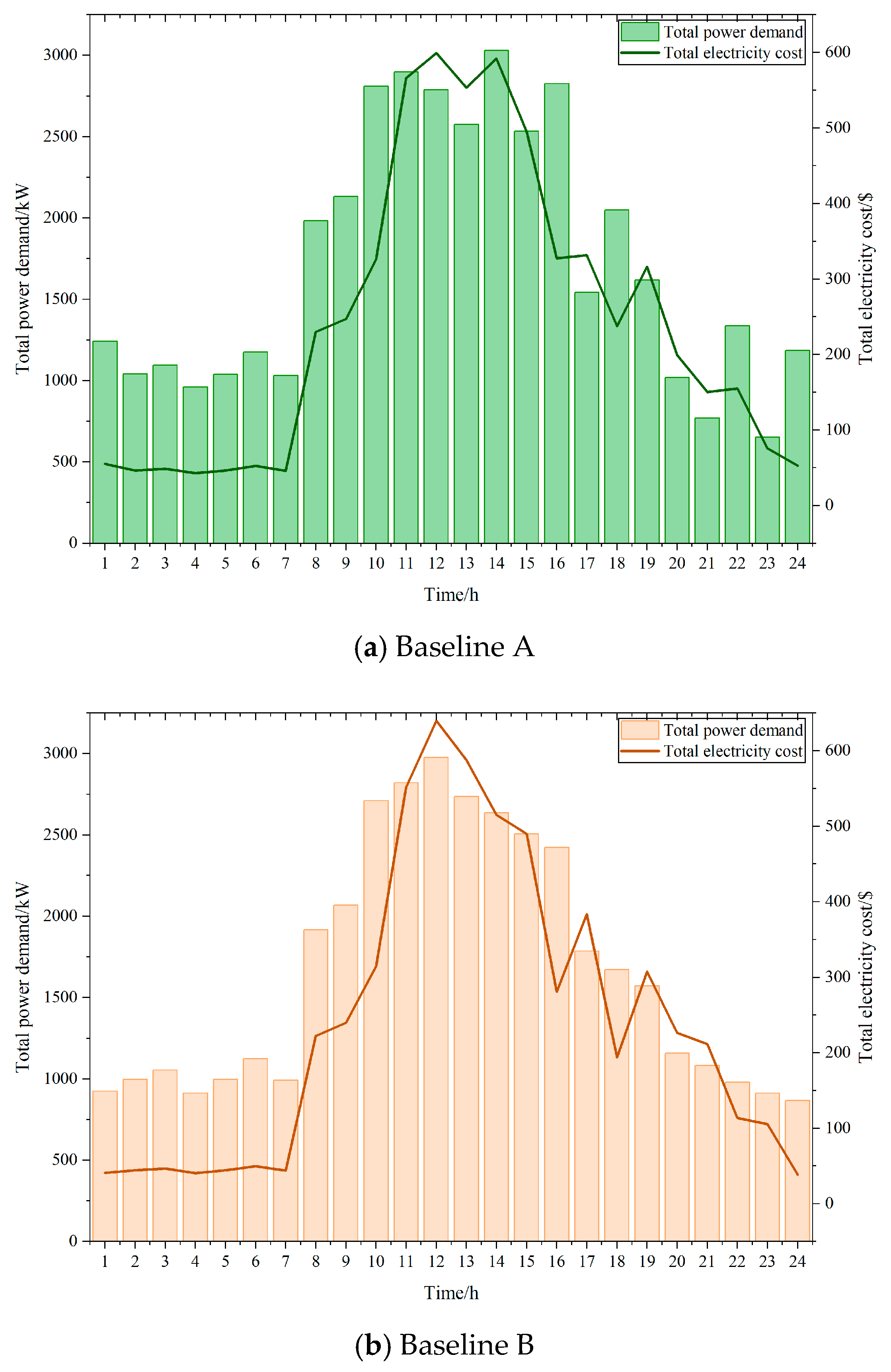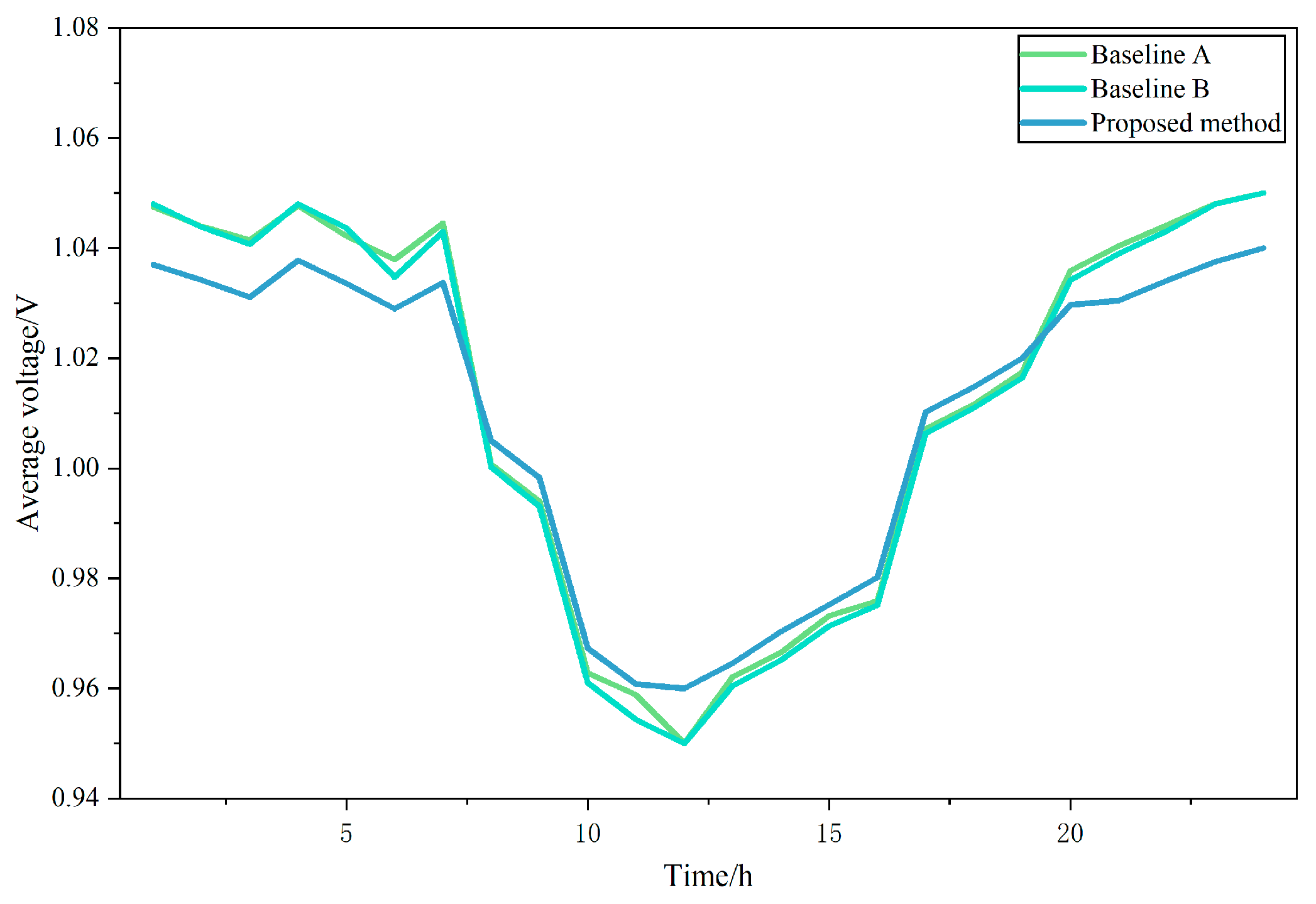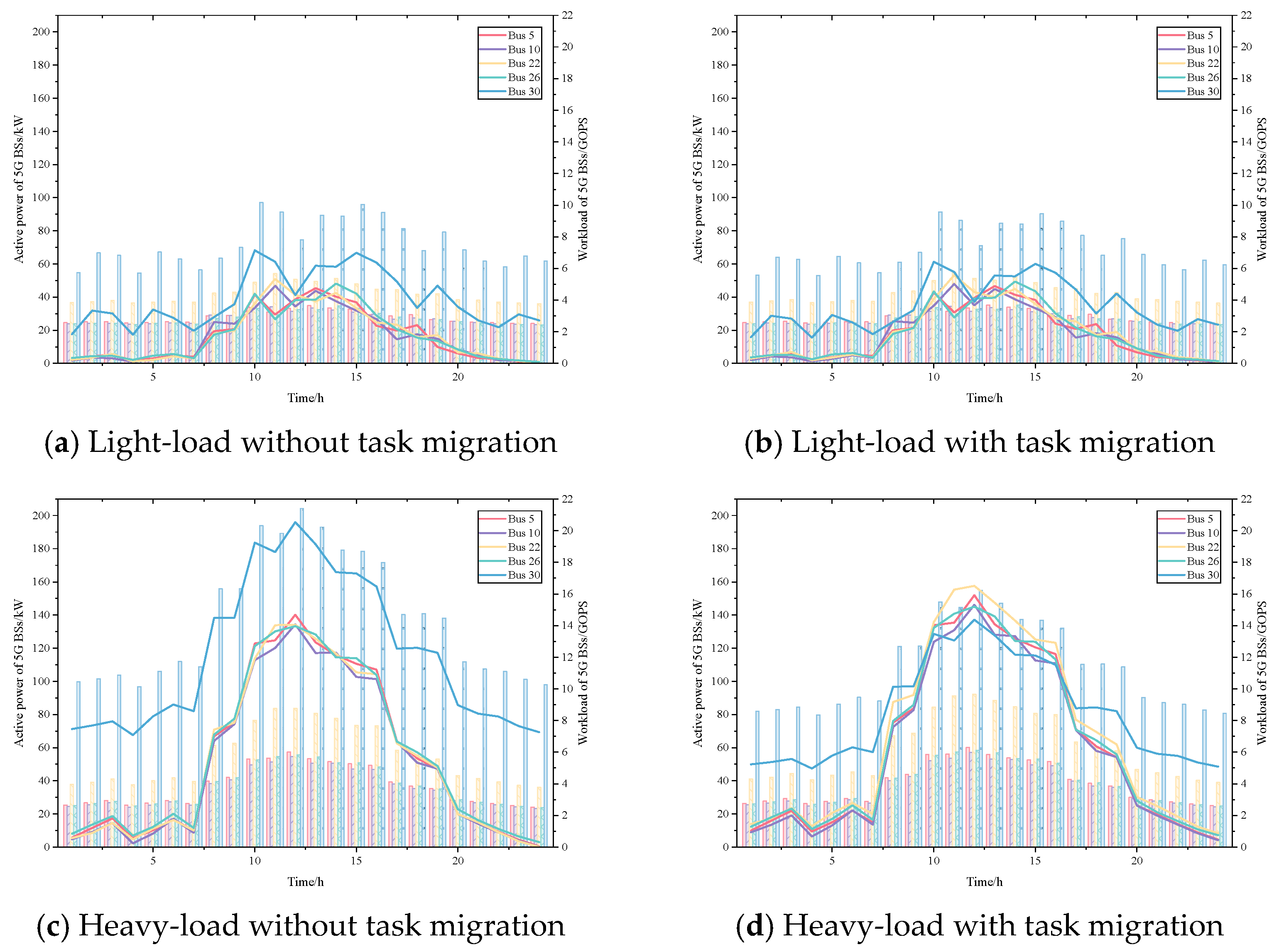Day-Ahead Coordinated Scheduling of Distribution Networks Considering 5G Base Stations and Electric Vehicles
Abstract
1. Introduction
- A dynamic load adjustment mechanism is proposed by modeling 5G BS computing task migration.
- A coordinated framework is developed for 5G BSs and EVs, considering 5G task migration, storage capabilities, and EV charging or discharging and mobility characteristics.
- A MISOCP model is formulated for day-ahead distribution network scheduling, integrating 5G BSs and EVs for improved operational efficiency and reliability.
2. Coordinated Interaction of 5G Base Stations and Electric Vehicles Incorporating Task Migration Strategy
2.1. Task Migration Strategy of 5G Base Stations
2.1.1. Power Characteristics of 5G Base Stations
2.1.2. Mathematical Modeling and Constraints of Task Migration
2.2. Coordinated Mechanism of 5G Base Stations and Electric Vehicles
2.2.1. EV Charging and Discharging Model
2.2.2. Coordination Mechanism Between 5G BSs and EVs
3. Day-Ahead Scheduling Model of Distribution Networks Considering 5G BSs and EVs
3.1. Objective Function
3.2. Constraints
3.2.1. Distribution System Constraints
3.2.2. EV Constraints
3.2.3. Fifth-Generation BS Constraints
3.2.4. Coordination Constraints Between 5G BSs and EVs
- Objective function: (26)
- Constraints: (3)–(25), (27)–(45)
4. Case Study
- Baseline A: Without task migration strategy but considering 5G-EV interaction
- Baseline B: With task migration strategy but without 5G-EV interaction
- Proposed Method: With task migration and 5G-EV interaction
5. Discussion
6. Conclusions
Author Contributions
Funding
Data Availability Statement
Conflicts of Interest
Abbreviations
| BS | Base Station |
| EV | Electric vehical |
| MISOCP | Mix-Integer Second-Order Cone Programming |
Appendix A
| DG No. | Location | Pmax (kW) | Qmax (kVar) |
|---|---|---|---|
| 1 | Bus 4 | 200 | 120 |
| 2 | Bus 23 | 250 | 150 |
| 5G BS No. | Location | Pidle (kW) | Ppeak (kW) | Emax (kWh) |
|---|---|---|---|---|
| 1 | Bus 5 | 24 | 58 | 20 |
| 2 | Bus 10 | 23.4 | 56.5 | 20 |
| 3 | Bus 22 | 36 | 87 | 20 |
| 4 | Bus 26 | 23 | 58 | 20 |
| 5 | Bus 30 | 40 | 200 | 20 |
| Bus No. | P (kW) | Q (kVar) |
|---|---|---|
| 1 | 0 | 0 |
| 2 | 100 | 60 |
| 3 | 90 | 40 |
| 4 | 120 | 80 |
| 5 | 60 | 30 |
| 6 | 60 | 20 |
| 7 | 200 | 100 |
| 8 | 200 | 100 |
| 9 | 60 | 20 |
| 10 | 60 | 20 |
| 11 | 45 | 30 |
| 12 | 60 | 35 |
| 13 | 60 | 35 |
| 14 | 120 | 80 |
| 15 | 60 | 10 |
| 16 | 60 | 20 |
| 17 | 60 | 20 |
| 18 | 90 | 40 |
| 19 | 90 | 40 |
| 20 | 90 | 40 |
| 21 | 90 | 40 |
| 22 | 90 | 40 |
| 23 | 90 | 50 |
| 24 | 420 | 200 |
| 25 | 420 | 200 |
| 26 | 60 | 25 |
| 27 | 60 | 25 |
| 28 | 60 | 20 |
| 29 | 120 | 70 |
| 30 | 200 | 600 |
| 31 | 150 | 70 |
| 32 | 210 | 100 |
| 33 | 60 | 40 |
| Branch No. | from | to | R (Ω) | X (Ω) |
|---|---|---|---|---|
| 1 | 1 | 2 | 0.0922 | 0.0470 |
| 2 | 2 | 3 | 0.4930 | 0.2511 |
| 3 | 3 | 4 | 0.3660 | 0.1864 |
| 4 | 4 | 5 | 0.3811 | 0.1941 |
| 5 | 5 | 6 | 0.8190 | 0.7070 |
| 6 | 6 | 7 | 0.1872 | 0.6188 |
| 7 | 7 | 8 | 0.7114 | 0.2351 |
| 8 | 8 | 9 | 1.0300 | 0.7400 |
| 9 | 9 | 10 | 1.0440 | 0.7400 |
| 10 | 10 | 11 | 0.1966 | 0.0650 |
| 11 | 11 | 12 | 0.3744 | 0.1298 |
| 12 | 12 | 13 | 1.4680 | 1.1550 |
| 13 | 13 | 14 | 0.5416 | 0.7129 |
| 14 | 14 | 15 | 0.5910 | 0.5260 |
| 15 | 15 | 16 | 0.7463 | 0.5450 |
| 16 | 16 | 17 | 1.2890 | 1.7210 |
| 17 | 17 | 18 | 0.7320 | 0.5740 |
| 18 | 2 | 19 | 0.1640 | 0.1565 |
| 19 | 19 | 20 | 1.5042 | 1.3554 |
| 20 | 20 | 21 | 0.4095 | 0.4784 |
| 21 | 21 | 22 | 0.7089 | 0.9373 |
| 22 | 3 | 23 | 0.4512 | 0.3083 |
| 23 | 23 | 24 | 0.8980 | 0.7091 |
| 24 | 24 | 25 | 0.8960 | 0.7011 |
| 25 | 6 | 26 | 0.2030 | 0.1034 |
| 26 | 26 | 27 | 0.2842 | 0.1447 |
| 27 | 27 | 28 | 1.0590 | 0.9337 |
| 28 | 28 | 29 | 0.8042 | 0.7006 |
| 29 | 29 | 30 | 0.5075 | 0.2585 |
| 30 | 30 | 31 | 0.9744 | 0.9630 |
| 31 | 31 | 32 | 0.3105 | 0.3619 |
| 32 | 32 | 33 | 0.3410 | 0.5302 |
| 33 | 8 | 21 | 2.0000 | 2.0000 |
| 34 | 9 | 15 | 2.0000 | 2.0000 |
| 35 | 12 | 22 | 2.0000 | 2.0000 |
| 36 | 18 | 33 | 0.5000 | 0.5000 |
| 37 | 25 | 29 | 0.5000 | 0.5000 |
References
- Agiwal, M.; Roy, A.; Saxena, N. Next generation 5G wireless networks: A comprehensive survey. IEEE Commun. Surv. Tutor. 2016, 18, 1617–1655. [Google Scholar] [CrossRef]
- Golive, S.G.; Paramasivam, B.; Ravindra, J. Impact of Electric Vehicle Charging Station in Distribution System: A Comprehensive Review. J. New Mater. Electrochem. Syst. 2024, 27, 77. [Google Scholar] [CrossRef]
- Hachemi, A.T.; Sadaoui, F.; Saim, A.; Ebeed, M.; Abbou, H.E.A.; Arif, S. Optimal Operation of Distribution Networks Considering Renewable Energy Sources Integration and Demand Side Response. Sustainability 2023, 15, 16707. [Google Scholar] [CrossRef]
- Ghosh, I. Making smart grid more smart with 5G communication. IEEE Smart Grid Newsl. 2021. Available online: https://smartgrid.ieee.org/bulletins/april-2021/making-smart-grid-more-smart-with-5g-communication (accessed on 1 October 2025).
- Yu, Z.; Yang, C.; Wang, Q. The impact of large-scale EV charging on the real-time operation of distribution systems: A comprehensive review. arXiv 2025, arXiv:2507.21759. [Google Scholar]
- Piovesan, N.; López-Pérez, D.; De Domenico, A.; Geng, X.; Bao, H.; Debbah, M. Machine learning and analytical power consumption models for 5G base stations. IEEE Commun. Mag. 2022, 60, 56–62. [Google Scholar] [CrossRef]
- Buzzi, S.; Chih-Lin, I.; Klein, T.E.; Poor, H.V.; Yang, C.; Zappone, A. A survey of energy-efficient techniques for 5G networks and challenges ahead. IEEE J. Sel. Areas Commun. 2016, 34, 697–709. [Google Scholar] [CrossRef]
- Zhang, N.; Guo, S.; Dong, Y.; Liu, D. Joint task offloading and data caching in mobile edge computing networks. Comput. Netw. 2020, 182, 107446. [Google Scholar] [CrossRef]
- Ge, X.; Yang, J.; Gharavi, H.; Sun, Y. Energy efficiency challenges of 5G small cell networks. IEEE Commun. Mag. 2017, 55, 184–191. [Google Scholar] [CrossRef]
- Kang, M.W.; Chung, Y.W. An efficient energy saving scheme for base stations in 5G networks with separated data and control planes using particle swarm optimization. Energies 2017, 10, 1417. [Google Scholar] [CrossRef]
- Prasad, K.N.R.S.V.; Hossain, E.; Bhargava, V.K. Energy efficiency in massive MIMO-based 5G networks: Opportunities and challenges. IEEE Wirel. Commun. 2017, 24, 86–94. [Google Scholar] [CrossRef]
- Padmakala, S.; Spandhana, D.M.; John, Y.M.; Shnain, A.H. Energy-Efficient Resource Allocation in 5G Wireless Networks using Asynchronous Advantage Actor-Critic based Reinforcement Learning. In Proceedings of the 2024 International Conference on Distributed Systems, Computer Networks and Cybersecurity (ICDSCNC), Bengaluru, India, 20–21 September 2024; pp. 1–5. [Google Scholar] [CrossRef]
- Rana, R.; Saggu, T.S.; Letha, S.S.; Bakhsh, F.I. V2G based bidirectional EV charger topologies and its control techniques: A review. Discov. Appl. Sci. 2024, 6, 588. [Google Scholar] [CrossRef]
- Zhang, G.; Liu, H.; Xie, T.; Li, H.; Zhang, K.; Wang, R. Research on the Dispatching of Electric Vehicles Participating in Vehicle-to-Grid Interaction: Considering Grid Stability and User Benefits. Energies 2024, 17, 812. [Google Scholar] [CrossRef]
- James, J.Q.; Li, V.O.K.; Lam, A.Y.S. Optimal V2G scheduling of electric vehicles and unit commitment using chemical reaction optimization. In Proceedings of the 2013 IEEE Congress on Evolutionary Computation, Cancun, Mexico, 20–23 June 2013; IEEE: Piscataway, NJ, USA, 2013; pp. 392–399. [Google Scholar]
- Chandran, S.; Sarma, S.M.D. Multi-Timescale Energy Management of Multi-Energy Virtual Power Plant Considering Carbon Trading Mechanism and V2G Interaction. IEEE Trans. Ind. Appl. 2025, 61, 2345–2358. [Google Scholar]
- Ran, Y.; Liao, H.; Liang, H.; Lu, L.; Zhong, J. Optimal Scheduling Strategies for EV Charging and Discharging in a Coupled Power–Transportation Network with V2G Scheduling and Dynamic Pricing. Energies 2024, 17, 6167. [Google Scholar] [CrossRef]
- Karfopoulos, E.L.; Hatziargyriou, N.D. Distributed coordination of electric vehicles providing V2G services. IEEE Trans. Power Syst. 2015, 31, 329–338. [Google Scholar] [CrossRef]
- Karimi, H.; Jadid, S.; Hasanzadeh, S. Optimal-sustainable multi-energy management of microgrid systems considering integration of renewable energy resources: A multi-layer four-objective optimization. Sustain. Prod. Consum. 2023, 36, 126–138. [Google Scholar] [CrossRef]
- Gao, X.; Xiao, H.; Xu, S.; Lin, H.C.; Chang, P. What Is the Optimal Solution for Scheduling Multiple Energy Systems? Overview and Analysis of Integrated Energy Co-Dispatch Models. Energies 2024, 17, 4718. [Google Scholar] [CrossRef]
- Aich, W.; Basem, A.; Sawaran Singh, N.S.; Mausam, K.; Hussein, Z.A.; Dixit, S.; Ali, N.B.; Said, L.B.; Rajhi, W.; Mostafazadeh, L. Two-layer energy scheduling of electrical and thermal smart grids with energy hubs including renewable and storage units considering energy markets. Sci. Rep. 2025, 15, 25079. [Google Scholar] [CrossRef] [PubMed]
- Zhang, N.; Liu, D.; Liu, T.; Zhang, X.; Guo, J.; Lan, F.; Li, Q.; Lu, W.; Yang, X. A Win-Win Coordinated Scheduling Strategy Between Flexible Load Resource Operators and Smart Grid in 5G Era. Energies 2025, 18, 1510. [Google Scholar] [CrossRef]
- Dai, Y.; Li, C.; Xia, S.; He, H.; Wang, P.; Jing, J. Collaborative optimization of distribution network and 5G base stations considering its communication load migration and energy storage dynamic backup flexibility. Int. J. Electr. Power Energy Syst. 2024, 160, 110124. [Google Scholar] [CrossRef]
- Han, J.; Liu, N.; Huang, Y.; Zhou, Z. Collaborative optimization of distribution network and 5G mobile network with renewable energy sources in smart grid. Int. J. Electr. Power Energy Syst. 2021, 130, 107027. [Google Scholar] [CrossRef]
- Zhang, W.; Zhu, T. Flexible resource demand response scheduling strategy under 5G-V2X. Sustain. Energy Grids Netw. 2024, 39, 101441. [Google Scholar] [CrossRef]
- Li, X.; Chen, Y.; Zhao, H.; Zhang, J. ECQ: An Energy-Efficient, Cost-Effective and QoS-Aware Method for Dynamic Service Migration in Mobile Edge Computing Systems. Wirel. Pers. Commun. 2024, 132, 2467–2501. [Google Scholar]
- Zhao, W.; Liu, P.; Zhang, Y.; Sun, J. Edge-Cloud Collaboration for Low-Latency, Low-Carbon, and Cost-Efficient Operations. Comput. Electr. Eng. 2024, 113, 109046. [Google Scholar] [CrossRef]
- Ahmed, M.; Zhou, X.; Li, K.; Wang, C. Cost Optimization in Edge Computing: A Survey. Artif. Intell. Rev. 2024, 57, 5639–5672. [Google Scholar] [CrossRef]
- Wang, T.; Zhang, H.; Xu, Y.; Li, Z. Dynamic Migration of Microservices for End-to-End Latency Control in 5G/6G Networks. J. Netw. Syst. Manag. 2023, 31, 45. [Google Scholar]
- Chen, R.; Liu, J.; Huang, T.; Xu, M. RASM: Resource-Aware Service Migration in Edge Computing Based on Deep Reinforcement Learning. J. Parallel Distrib. Comput. 2023, 176, 104745. [Google Scholar]
- Sharma, S.; Gupta, V.; Li, Y.; Alshamrani, A. QoS-Aware Resource Allocation for Coexistence Mechanisms between eMBB and URLLC: Issues, Challenges, and Future Directions in 5G. Comput. Commun. 2024, 213, 14–28. [Google Scholar]
- Ge, X.; Sun, Y.; Gharavi, H.; Thompson, J. Joint Optimization of Computation and Communication Power in Multi-User Massive MIMO Systems. IEEE Trans. Wirel. Commun. 2018, 17, 4051–4066. [Google Scholar] [CrossRef]
- Barroso, L.A.; Hölzle, U. The Case for Energy-Proportional Computing. IEEE Comput. 2007, 40, 33–37. [Google Scholar] [CrossRef]
- Meisner, D.; Gold, B.T.; Wenisch, T.F. PowerNap: Eliminating Server Idle Power. In Proceedings of the 14th International Conference on Architectural Support for Programming Languages and Operating Systems (ASPLOS XIV), Washington, DC, USA, 7–11 March 2009; pp. 205–216. [Google Scholar]
- Dabbagh, M.; Hamdaoui, B.; Guizani, M.; Rayes, A. Energy-Efficient Resource Allocation for Cloud-Based 5G Mobile Networks. IEEE Trans. Netw. Serv. Manag. 2015, 12, 438–451. [Google Scholar] [CrossRef]
- Shang, Y.; Zheng, Y.; Shao, Z.; Jian, L. Computational performance analysis for centralized coordinated charging methods of plug-in electric vehicles: From the grid operator perspective. Int. Trans. Electr. Energy Syst. 2020, 30, e12229. [Google Scholar] [CrossRef]
- Li, Z.; Shang, Y.; Lei, X.; Shao, Z.; Jia, Y.; Jian, L. An accessible close-loop V2V charging mechanism under charging station with non-cooperative game. Energy Rep. 2022, 8, 1038–1044. [Google Scholar] [CrossRef]
- Zhang, X.; Zhang, R.; Zhang, W.G.; Cao, G. N-1 Evaluation of Integrated Electricity and Gas System Considering Cyber-Physical Interdependence. IEEE Trans. Smart Grid 2025, 16, 3728–3742. [Google Scholar] [CrossRef]









| Time Period (h) | Electricity Price ($/kWh) | |
|---|---|---|
| Critical Peak | 11:00–13:00 16:00–17:00 | 0.2149 |
| Peak | 10:00–11:00 13:00–15:00 18:00–21:00 | 0.1954 |
| Level | 7:00–10:00 15:00–16:00 17:00–18:00 21:00–23:00 | 0.1159 |
| Valley | 23:00–7:00 | 0.04441 |
| Strategy | Total Power Demand | Total Electricity Cost |
|---|---|---|
| Baseline A | 41,328.8 kWh | 5790.19 |
| Baseline B | 39,825.0 kWh | 5584.40 |
| Proposed Method | 39,129.4 kWh | 5489.78 |
| Strategy | Binary Variables | Continuous Variables | Total Constraints | MIP Gap Settings | Solution Time |
|---|---|---|---|---|---|
| Baseline A | 3840 | 6240 | 8160 | 1 × 10−4 | 309s |
| Baseline B | 4010 | 8160 | 10,080 | 1 × 10−4 | 533s |
| Proposed Method | 4180 | 9120 | 11,040 | 1 × 10−4 | 652s |
| 5G BS No. | αi | βi |
|---|---|---|
| Bus 5 | 2.27 W/GOPS | 24 W |
| Bus 10 | 2.21 W/GOPS | 23.4 W |
| Bus 22 | 3.40 W/GOPS | 36 W |
| Bus 26 | 2.33 W/GOPS | 23 W |
| Bus 30 | 8.00 W/GOPS | 40 W |
| Scenarios | Total Power Demand | Total Electricity Cost |
|---|---|---|
| Light-load | 16,677.6 kWh | 2373.84 |
| Heavy-load | 49,515.3 kWh | 6919.74 |
Disclaimer/Publisher’s Note: The statements, opinions and data contained in all publications are solely those of the individual author(s) and contributor(s) and not of MDPI and/or the editor(s). MDPI and/or the editor(s) disclaim responsibility for any injury to people or property resulting from any ideas, methods, instructions or products referred to in the content. |
© 2025 by the authors. Licensee MDPI, Basel, Switzerland. This article is an open access article distributed under the terms and conditions of the Creative Commons Attribution (CC BY) license (https://creativecommons.org/licenses/by/4.0/).
Share and Cite
Peng, L.; Zhou, A.; Qiao, J.; Sun, Q.; Qian, Z.; Xu, M.; Pan, S. Day-Ahead Coordinated Scheduling of Distribution Networks Considering 5G Base Stations and Electric Vehicles. Electronics 2025, 14, 3940. https://doi.org/10.3390/electronics14193940
Peng L, Zhou A, Qiao J, Sun Q, Qian Z, Xu M, Pan S. Day-Ahead Coordinated Scheduling of Distribution Networks Considering 5G Base Stations and Electric Vehicles. Electronics. 2025; 14(19):3940. https://doi.org/10.3390/electronics14193940
Chicago/Turabian StylePeng, Lin, Aihua Zhou, Junfeng Qiao, Qinghe Sun, Zhonghao Qian, Min Xu, and Sen Pan. 2025. "Day-Ahead Coordinated Scheduling of Distribution Networks Considering 5G Base Stations and Electric Vehicles" Electronics 14, no. 19: 3940. https://doi.org/10.3390/electronics14193940
APA StylePeng, L., Zhou, A., Qiao, J., Sun, Q., Qian, Z., Xu, M., & Pan, S. (2025). Day-Ahead Coordinated Scheduling of Distribution Networks Considering 5G Base Stations and Electric Vehicles. Electronics, 14(19), 3940. https://doi.org/10.3390/electronics14193940





